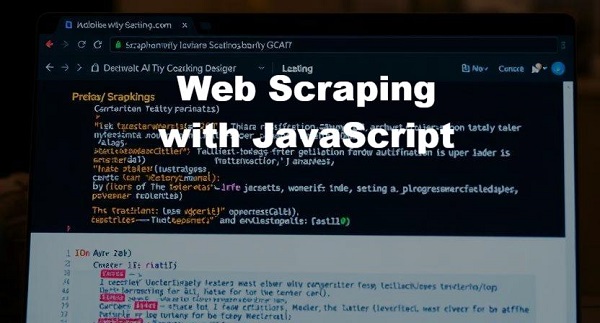3 Methods to Set Up a Reverse Proxy on a Home Network
Step-by-step guide to install and configure NGINX, Apache, or Caddy as a reverse proxy for home servers, complete with SSL, security, and troubleshooting tips.
Post Time:2025-04-29
Explore web scraping with JavaScript: tools, steps, and MacroProxy solutions for dynamic data extraction.
Web scraping has become an indispensable tool for online data extraction, especially for scaling information. Dynamic JavaScript-driven websites have become mainstream, thus mastering JavaScript web scraping is a powerful way to access and process data that traditional methods might miss. This guide explores the basics of web scraping with JavaScript, provides actionable steps, and highlights how proxy solutions enhance the process by overcoming common challenges like IP bans and geo-restrictions.

Web scraping is programmatically extracting data from websites. It serves various purposes, ranging from market research to competitive analysis and content aggregation. Unlike static HTML scraping, modern websites often rely on JavaScript to load content dynamically.
JavaScript excels at handling dynamic content. Its ecosystem includes robust libraries that simplify automation, ideal for scraping complex, interactive sites.
Scraping presents hurdles such as IP blocking, CAPTCHAs, and rate limits. Dynamic content further complicates the process, requiring tools capable of rendering JavaScript and solutions to maintain anonymity and access.
A Node.js library for controlling headless Chrome or Chromium browsers. It excels at rendering dynamic content and automating browser tasks.
A lightweight tool for parsing static HTML, best suited for simple, non-dynamic sites.
A library for making HTTP requests, often paired with Cheerio for fetching web pages.
Each tool suits specific scenarios: Puppeteer for dynamic sites, Cheerio for static content, and Axios for lightweight requests.
Puppeteer stands out for its versatility in scraping JavaScript-heavy websites.
Install Puppeteer via npm:
npm install puppeteer
This installs a headless Chromium instance for browser automation.
Extract titles from a webpage:
javascript
const puppeteer = require('puppeteer');
(async () => {
const browser = await puppeteer.launch();
const page = await browser.newPage();
await page.goto('https://example.com');
const titles = await page.evaluate(() =>
Array.from(document.querySelectorAll('h1')).map(h1 => h1.textContent)
);
console.log(titles);
await browser.close();
})();
This script launches a browser, navigates to a URL, and retrieves all <h1> elements.
For sites loading data via JavaScript, wait for elements to appear:
javascript
await page.waitForSelector('.dynamic-content');
const data = await page.evaluate(() =>
document.querySelector('.dynamic-content').innerText
);
The waitForSelector method ensures content is fully loaded before extraction.
Handle login pages by inputting credentials:
javascript
await page.type('#username', 'user');
await page.type('#password', 'pass');
await page.click('#login-button');
await page.waitForNavigation();
This automates login, enabling access to restricted content.
Websites often block scrapers by detecting repetitive IP requests. Rotating proxies mitigate this by assigning new IP addresses per request, mimicking organic traffic.
CAPTCHAs disrupt scraping by requiring human interaction. Using residential proxies reduces CAPTCHA triggers, as these IPs appear legitimate to servers.
Distributing requests across multiple IPs prevents server overload and bans. High-quality proxy pools ensure scalability and reliability.
Proxies are vital for successful web scraping, especially at scale. MacroProxy offers specialized solutions tailored to these needs.
Proxies mask the scraper’s IP, bypass geo-restrictions, and prevent bans. For JavaScript scraping, where rendering pages increases request frequency, proxies ensure uninterrupted access.
MacroProxy provides scraping proxies featuring a vast pool of rotating residential IPs. These proxies integrate seamlessly with Puppeteer:
javascript
const puppeteer = require('puppeteer');
(async () => {
const browser = await puppeteer.launch({
args: ['--proxy-server=http://proxy.macroproxy.com:port']
});
const page = await browser.newPage();
await page.authenticate({ username: 'macroproxy_user', password: 'macroproxy_pass' });
await page.goto('https://example.com');
console.log(await page.title());
await browser.close();
})();
Businesses scraping for advertising delivery benefit from MacroProxy’s dynamic residential proxies. These IPs, sourced from real devices, blend into traffic patterns, making them ideal for collecting ad data without detection. Detailed documentation and support ease implementation, even for users new to proxies.
Respect website terms of service and robots.txt files. Avoid overloading servers by spacing requests appropriately.
Minimize resource use by running Puppeteer in headless mode and disabling images:
javascript
await puppeteer.launch({ headless: true, args: ['--no-images'] });
Regularly test scrapers against target site updates. MacroProxy’s reliable proxy pool ensures consistent access despite changes.
Static scraping extracts data from pre-loaded HTML, while dynamic scraping targets JavaScript-rendered content. MacroProxy’s proxies ensure reliable access to both, supporting tools like Cheerio and Puppeteer.
Rotating proxies, randomized delays, and human-like behavior reduce detection risks. Rotating residential proxies provide fresh IPs per request, ideal for stealthy scraping.
Proxies prevent IP bans, unlock geo-restricted data, and distribute requests. MacroProxy’s extensive IP pool supports large-scale scraping without interruptions.
Yes, our proxies work across languages like Python or Java, offering flexibility for diverse scraping projects beyond JavaScript.
Web scraping with JavaScript unlocks a wealth of data from modern websites, made accessible through tools like Puppeteer and enhanced by MacroProxy’s proxy solutions. This guide provides a clear path—from setup to advanced techniques—while addressing user concerns with practical steps and expert insights. Leveraging our scraping proxies to ensure seamless, scalable, and ethical data extraction. Sign up today to get your free trial today!
< Previous
Next >